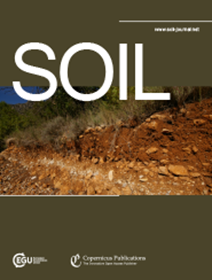Mapping near real-time soil moisture dynamics over Tasmania with transfer learning
IF 5.8
2区 农林科学
Q1 SOIL SCIENCE
引用次数: 0
Abstract
Abstract. Soil moisture, an essential parameter for hydroclimatic studies, exhibits significant spatial and temporal variability, making it challenging to map at fine spatiotemporal resolutions. Although current remote sensing products provide global soil moisture estimate at a fine temporal resolution, they are mostly at a coarse spatial resolution. In recent years, deep learning (DL) has been applied to generate high-resolution maps of various soil properties, but DL requires a large amount of training data. This study aimed to map daily soil moisture across Tasmania, Australia at 80 meters resolution based on a limited set of training data. We assessed three modelling strategies: DL models calibrated using an Australian dataset (51,411 observation points), models calibrated using the Tasmanian dataset (9,825 observation points), and a transfer learning technique that transferred information from Australian models to Tasmania. We also evaluated two DL approaches, i.e. Multilayer perceptron (MLP) and Long Short-Term Memory (LSTM). Our models included data of Soil Moisture Active Passive (SMAP) dataset, weather data, elevation map, land cover and multilevel soil properties maps as inputs to generate soil moisture at the surface (0–30 cm) and subsurface (30–60 cm) layers. Results showed that (1) models calibrated from the Australia dataset performed worse than Tasmanian models regardless of the type of DL approaches; (2) Tasmanian models, calibrated solely using Tasmanian data, resulted in shortcomings in predicting soil moisture; and (3) Transfer learning exhibited remarkable performance improvements (error reductions of up to 45 % and a 50 % increase in correlation) and resolved the drawbacks of the Tasmanian models. The LSTM models with transfer learning had the highest overall performance with an average mean absolute error (MAE) of 0.07 m3m-3 and a correlation coefficient (r) of 0.77 across stations for surface layer and MAE = 0.07 m3m-3, and r = 0.69 for subsurface layer. The fine-resolution soil moisture maps captured the detailed landscape variation as well as temporal variation according to four distinct seasons in Tasmania. The best performance of soil moisture models were made available live to predict near-real-time daily soil moisture of Tasmania, assisting agricultural decision making.利用迁移学习绘制塔斯马尼亚上空近实时土壤水分动态图
摘要土壤水分是水文气候研究的一个重要参数,具有显著的时空变异性,因此以精细的时空分辨率绘制土壤水分图具有挑战性。虽然目前的遥感产品可以提供精细时间分辨率的全球土壤水分估算,但它们大多是粗空间分辨率的。近年来,深度学习(DL)已被用于生成各种土壤特性的高分辨率地图,但深度学习需要大量的训练数据。本研究旨在基于有限的训练数据集,绘制澳大利亚塔斯马尼亚州 80 米分辨率的日土壤湿度图。我们评估了三种建模策略:使用澳大利亚数据集(51,411 个观测点)校准的 DL 模型、使用塔斯马尼亚数据集(9,825 个观测点)校准的模型,以及将澳大利亚模型中的信息转移到塔斯马尼亚的转移学习技术。我们还评估了两种 DL 方法,即多层感知器(MLP)和长短期记忆(LSTM)。我们的模型包括土壤水分主动被动(SMAP)数据集、气象数据、高程图、土地覆盖和多层次土壤特性图作为输入,以生成表层(0-30 厘米)和次表层(30-60 厘米)的土壤水分。结果表明:(1) 无论采用哪种 DL 方法,根据澳大利亚数据集校准的模型的性能都比塔斯马尼亚模型差;(2) 仅使用塔斯马尼亚数据校准的塔斯马尼亚模型在预测土壤湿度方面存在缺陷;(3) 迁移学习显著提高了性能(误差减少达 45%,相关性提高 50%),解决了塔斯马尼亚模型的缺点。采用迁移学习的 LSTM 模型总体性能最高,平均绝对误差(MAE)为 0.07 m3m-3,各站表层相关系数(r)为 0.77,MAE = 0.07 m3m-3,次表层相关系数(r)为 0.69。精细分辨率的土壤水分图捕捉到了塔斯马尼亚州详细的地貌变化以及四季分明的时间变化。土壤水分模型的最佳性能可用于实时预测塔斯马尼亚近实时的每日土壤水分,从而帮助农业决策。
本文章由计算机程序翻译,如有差异,请以英文原文为准。
求助全文
约1分钟内获得全文
求助全文
来源期刊

Soil
Agricultural and Biological Sciences-Soil Science
CiteScore
10.80
自引率
2.90%
发文量
44
审稿时长
30 weeks
期刊介绍:
SOIL is an international scientific journal dedicated to the publication and discussion of high-quality research in the field of soil system sciences.
SOIL is at the interface between the atmosphere, lithosphere, hydrosphere, and biosphere. SOIL publishes scientific research that contributes to understanding the soil system and its interaction with humans and the entire Earth system. The scope of the journal includes all topics that fall within the study of soil science as a discipline, with an emphasis on studies that integrate soil science with other sciences (hydrology, agronomy, socio-economics, health sciences, atmospheric sciences, etc.).
 求助内容:
求助内容: 应助结果提醒方式:
应助结果提醒方式:


